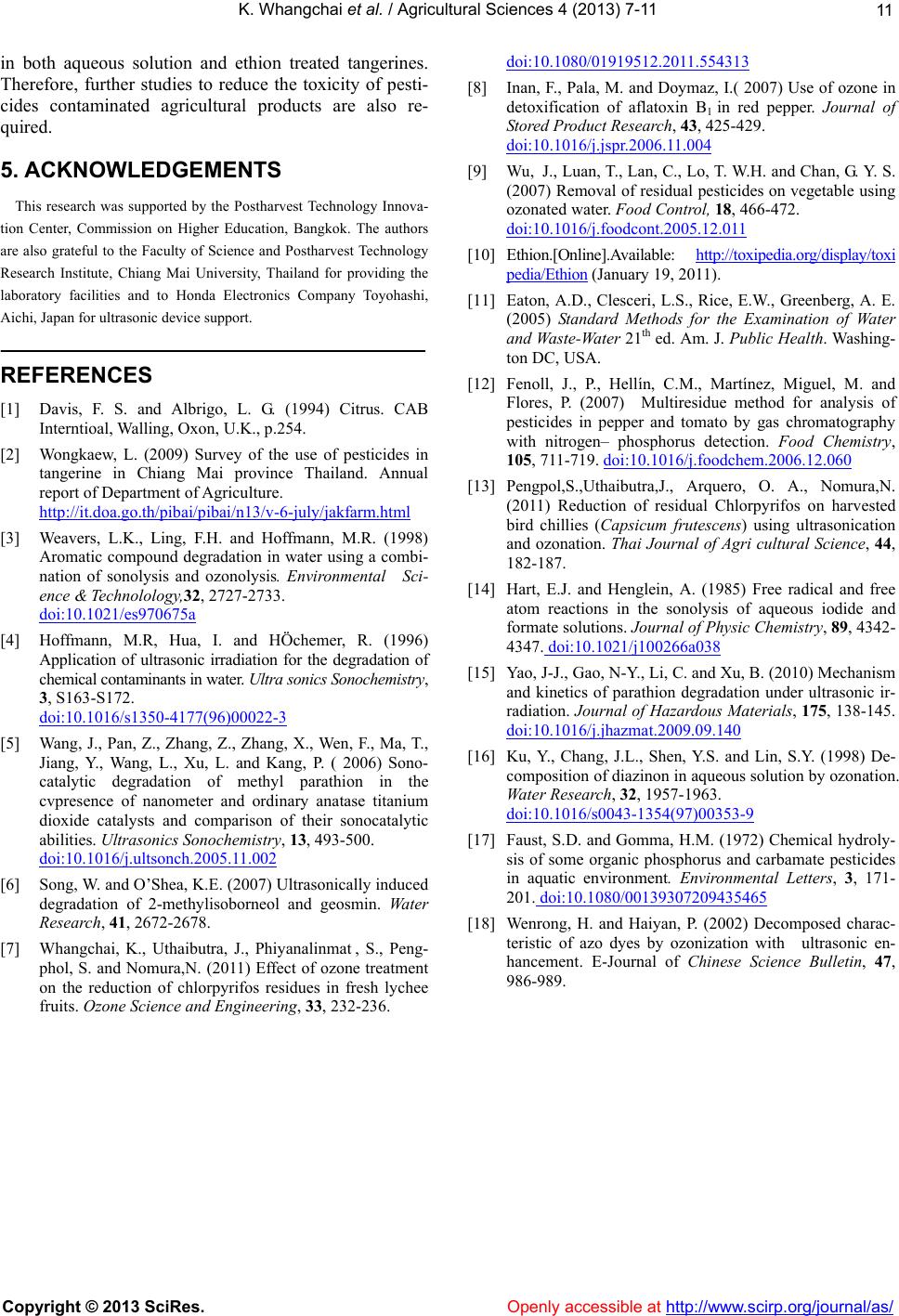
K. Whangchai et al. / Agricultural Sciences 4 (2013) 7-11
Copyright © 2013 SciRes. http://www.scirp.org/journal/as/
11
in both aqueous solution and ethion treated tangerines.
Therefore, further studies to reduce the toxicity of pesti-
cides contaminated agricultural products are also re-
quired.
Openly accessible at
5. ACKNOWLEDGEMENTS
This research was supported by the Postharvest Technology Innova-
tion Center, Commission on Higher Education, Bangkok. The authors
are also grateful to the Faculty of Science and Postharvest Technology
Research Institute, Chiang Mai University, Thailand for providing the
laboratory facilities and to Honda Electronics Company Toyohashi,
Aichi, Japan for ultrasonic device support.
REFERENCES
[1] Davis, F. S. and Albrigo, L. G. (1994) Citrus. CAB
Interntioal, Walling, Oxon, U.K., p.254.
[2] Wongkaew, L. (2009) Survey of the use of pesticides in
tangerine in Chiang Mai province Thailand. Annual
report of Department of Agriculture.
http://it.doa.go.th/pibai/pibai/n13/v-6-july/jakfarm.html
[3] Weavers, L.K., Ling, F.H. and Hoffmann, M.R. (1998)
Aromatic compound degradation in water using a combi-
nation of sonolysis and ozonolysis. Environmental Sci-
ence & Technolology,32, 2727-2733.
doi:10.1021/es970675a
[4] Hoffmann, M.R, Hua, I. and HÖchemer, R. (1996)
Application of ultrasonic irradiation for the degradation of
chemical contaminants in water. Ultra sonics Sonochemistry,
3, S163-S172.
doi:10.1016/s1350-4177(96)00022-3
[5] Wang, J., Pan, Z., Zhang, Z., Zhang, X., Wen, F., Ma, T.,
Jiang, Y., Wang, L., Xu, L. and Kang, P. ( 2006) Sono-
catalytic degradation of methyl parathion in the
cvpresence of nanometer and ordinary anatase titanium
dioxide catalysts and comparison of their sonocatalytic
abilities. Ultrasonics Sonochemistry, 13, 493-500.
doi:10.1016/j.ultsonch.2005.11.002
[6] Song, W. and O’Shea, K.E. (2007) Ultrasonically induced
degradation of 2-methylisoborneol and geosmin. Water
Research, 41, 2672-2678.
[7] Whangchai, K., Uthaibutra, J., Phiyanalinmat , S., Peng-
phol, S. and Nomura,N. (2011) Effect of ozone treatment
on the reduction of chlorpyrifos residues in fresh lychee
fruits. Ozone Science and Engineering, 33, 232-236.
doi:10.1080/01919512.2011.554313
[8] Inan, F., Pala, M. and Doymaz, I.( 2007) Use of ozone in
detoxification of aflatoxin B1 in red pepper. Journal of
Stored Product Research, 43, 425-429.
doi:10.1016/j.jspr.2006.11.004
[9] Wu, J., Luan, T., Lan, C., Lo, T. W.H. and Chan, G. Y. S.
(2007) Removal of residual pesticides on vegetable using
ozonated water. Food Control, 18, 466-472.
doi:10.1016/j.foodcont.2005.12.011
[10] Ethion.[Online].Available: http://toxipedia.org/display/toxi
pedia/Ethion (January 19, 2011).
[11] Eaton, A.D., Clesceri, L.S., Rice, E.W., Greenberg, A. E.
(2005) Standard Methods for the Examination of Water
and Waste-Water 21th ed. Am. J. Public Health. Washing-
ton DC, USA.
[12] Fenoll, J., P., Hellín, C.M., Martínez, Miguel, M. and
Flores, P. (2007) Multiresidue method for analysis of
pesticides in pepper and tomato by gas chromatography
with nitrogen– phosphorus detection. Food Chemistry,
105, 711-719. doi:10.1016/j.foodchem.2006.12.060
[13] Pengpol,S.,Uthaibutra,J., Arquero, O. A., Nomura,N.
(2011) Reduction of residual Chlorpyrifos on harvested
bird chillies (Capsicum frutescens) using ultrasonication
and ozonation. Thai Journal of Agri cultural Science, 44,
182-187.
[14] Hart, E.J. and Henglein, A. (1985) Free radical and free
atom reactions in the sonolysis of aqueous iodide and
formate solutions. Journal of Physic Chemistry, 89, 4342-
4347. doi:10.1021/j100266a038
[15] Yao, J-J., Gao, N-Y., Li, C. and Xu, B. (2010) Mechanism
and kinetics of parathion degradation under ultrasonic ir-
radiation. Journal of Hazardous Materials, 175, 138-145.
doi:10.1016/j.jhazmat.2009.09.140
[16] Ku, Y., Chang, J.L., Shen, Y.S. and Lin, S.Y. (1998) De-
composition of diazinon in aqueous solution by ozonation.
Water Research, 32, 1957-1963.
doi:10.1016/s0043-1354(97)00353-9
[17] Faust, S.D. and Gomma, H.M. (1972) Chemical hydroly-
sis of some organic phosphorus and carbamate pesticides
in aquatic environment. Environmental Letters, 3, 171-
201. doi:10.1080/00139307209435465
[18] Wenrong, H. and Haiyan, P. (2002) Decomposed charac-
teristic of azo dyes by ozonization with ultrasonic en-
hancement. E-Journal of Chinese Science Bulletin, 47,
986-989.